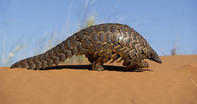
Name
Pangolin, ground pangolin, Temminck’s pangolin or the Cape pangolin (Manis temminckii)Order
PholiodotaFamily
ManidaeAppearance
The pangolin is about 1 m in length with a mass from 4.5 kg to 14.5 kg. It is distinguished from other mammals by its imbricated brown scales which serve as protection. Apart from its forehead, the pangolin does not have scales on its underside, inner legs or head.
The pangolin’s front legs are shorter than its hind legs. On its forefeet, the middle three digits and claws are suited for digging and the first and last digits are reduced. Its tail is broad at the base, narrowing to a round tip.
Pangolin Diet
Pangolins are wholly insectivorous. They can be found where there is an abundance of ants and termites, and where burrows or other forms of shelter are obtainable. Being very particular in their feeding, pangolins eat only 19 specific ants and termites, which they locate by smell.
They can even smell prey under the soil surface. The pangolin sticks its 250mm long, straight tongue covered in sticky saliva into termite tunnels to trap prey, feeding about 90 times per night for one minute. The sand ingested when eating helps the pangolin in masticating its food in its muscular mouth.
Pangolin Breeding
After a gestation period of about 135 days, a female gives birth to a single young. in South Africa, a pangolin pair breeds for 1-2 days during March, and birthing occurs during July or August.
Mating happens side by side, and the male forces his tail under the female to help the mating process. Mothers hide their young in a den while they go foraging, and often move them to a new den after their first month of birth.
Pangolin Behaviour
Rolling into a ball when threatened and being able to cut with its razor-sharp scales, the pangolin can readily defend itself. They also have scent glands used to spray their enemies, similar to those of a skunk. They can saunter around on all fours, but when needing to move speedily they stand on two feet and use their tails for support. Pangolins can move at a speed of 5 km/h.Pangolin Habitat
In South Africa, the savanna woodlands are the pangolin’s choice of habitat, but they can also be found on floodplain grasslands, sandveld and rocky slopes, although not in forests or deserts.Where They Are Found
Pangolins can be found in South Africa in northern KwaZulu-Natal, Mpumalanga, Limpopo and parts of North West. It can also be found in Zimbabwe, Mozambique, Botswana and Namibia.Interesting Facts
Pangolins are endangered animals. They are hunted for their skins which are used to make leather boots, for their scales which are used in Chinese and African medicines, and for their meat. Their habitats are also being destroyed. Of the seven species included in the Pholidota – pangolins or scaled anteaters – three Asian species and one African species are endangered.
Four of the species are in Africa and three in Asia. They used to be more widely distributed around the world. A fairly new fossil of a pangolin Eomanis was found of Eocene Germany, and another was found in the lower Oligocene in North America.
 Learning about the mammals of South Africa is now so much easier for all South Africans - SouthAfrica.co.za is an excellent source of inform...
Learning about the mammals of South Africa is now so much easier for all South Africans - SouthAfrica.co.za is an excellent source of inform...